How Do Charter Schools
Affect Public Education?
By Jill Jenkins
According to a September 28, 2014
article, “Charter
Schools and the Risk of Increased Segregation” by Iris C. Rotbert of Phi Delta
Kappan, “We need only turn to a large body of relevant research showing that
charter schools, on average, don’t have an academic advantage over traditional
public schools (Gill et al., 2007; Gleason, Clark, Tuttle, & Dwoyer, 2010),
but they do have a significant risk of leading to increased segregation
(Booker, Zimmer, & Buddin, 2005; Gulosino & d’Entremont, 2011).” Attending a racially diverse school allows
students to interact with all kinds of people. As a result, it reduces hatred
and mistrust. People tend to hate and
mistrust what they don’t understand. Besides increasing segregation, charter
schools use public funds, but do not have to adhere to the same rules including
class size and they do not show a significant improvement in the education
provided to students in regular schools while using some of the money that
would have been allocated to regular schools.
As a result, it seems the public schools are not necessarily good for
our country.
I decided to
review the data from my state, Utah.
Utah is not a very racially diverse state, so perhaps integrating
schools is even more important. According to a report entitled, “Utah’s Public Charter Schools
2012-2013 Annual Report”, the average percentage of minorities in across the state that year was
24%, but in Charter Schools it was 21%.
That didn’t seem that big of a difference until I found another report
entitled, “Fall Enrollment October 2013”, a report that showed the population
composition of each school in the state.
Some of them were listed as charter schools and some that I knew were
charter schools were listed within each district, so it was confusing. What I found was a few charter schools had
high percentages of minority students ranging from 98% to 72%, but an
extraordinary number of charter schools had between 10% to 12% minority. The chart below appears in “Utah Public Charter Schools
2012-2013 Annual Report” from the Utah State Department of Education page 21:
The report
also illustrate that there has been growth in each of the subgroups in charter school.
Although the data shows that there is growth, what it doesn’t show is that
growth may only be in a few schools, not across the board. I have the feeling that the growth is only in
isolated schools.
Furthermore,
I found that in the report “Fall Enrollment October 2013”, the enrollment in these charter
schools is considerably smaller than the public schools with the largest
charter school being 1,956 K-12 grade students and the largest public school
housed only 10-12 grades having 2,507 students.
The smallest charter school has a population of only 3 students enrolled
with many charter schools enrollment in the 7-16 student range. The smallest public schools were in the 200
student range. Since charter schools can control their class size and their
enrollment there is a considerable difference between the two types of schools.
I believed that charter schools could also select their students meaning they
can avoid students who struggle or are disruptive. That wasn’t exactly true
according to the report “Utah Public Charter Schools
2012-2013.” Charter schools must accept all applications
as long as there is space available.
They give priority to students living in their area, the children of
parents who helped establish the school, or work at the school in a paid or
volunteer capacity and the children who have siblings attending the
school. However, when all student slots
are filled the remaining students are to be placed on a waiting list. The school, however, can determine how many
student slots exist. This means they do
not have to adhere to the staffing ratios established by the state for regular
schools. They can also select their own
policies for dismissing a student.
I also believed that charter schools were high performing schools because of their smaller class size; however I was wrong again. My own grandchildren attend one because their parents wanted a quality education for their children. Just as guilty, I sent my daughter to private schools and parochial schools to ensure that she got the best education I could afford. I understand why many people feel that charter schools are the answer. The truth is according to the state data found in, “Utah’s Public Charter Schools Annual Report 2012-2013.” First, the test average Criterion Reference Test was almost exactly the same as the average scores of students in regular schools.
Graduation rates are another area
where charter schools fall behind regular schools. In the chart below, from the
Utah State Office of Education’s report “Utah’s
Public Charter Schools Annual Report 2012-2013,” charter schools’
performance fails to live up to the regular schools’ performance:
Considering how small the differences in performance in the average charter school to the district school actually are and the ludicrously small number of student from each of these subgroups that charter schools enroll, it seems questionable if they really are a significant improvement in education. Referring back to the report, the conclusion of the state was that although there are a few outstanding charter schools, more of the charter schools received an “F” from the state’s school grading program, “Further, compared to district schools, a higher percentage of charter schools earned an F (8.5% of charters compared to 3.2% of district schools).
In conclusion, the data does not
show that charter schools make a significant improvement in education; however, they continue to use the tax dollars that could improve public
schools. They do not serve enough
students to make investing in them cost-effective. I think they hurt public
schools, not help them, because they use funds that would have been allocated
for all students in public education.
















